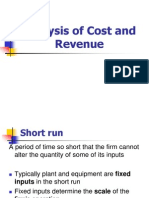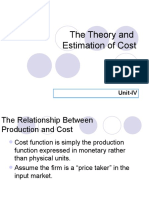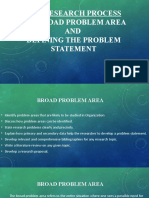0 ratings0% found this document useful (0 votes)
63 views2 Short Run Cost Jalil Sir
2 Short Run Cost Jalil Sir
Uploaded by
api-276073307This document discusses short-run costs and output decisions for firms in perfectly competitive industries. It defines different types of costs including fixed costs, variable costs, total costs, average costs and marginal costs. It explains how these costs change with different levels of output in the short-run and their relationships. The document also discusses total revenue, marginal revenue and how profit-maximizing firms will produce the output where marginal revenue equals marginal cost to maximize profits.
Copyright:
© All Rights Reserved
Available Formats
Download as PPT, PDF, TXT or read online from Scribd
2 Short Run Cost Jalil Sir
2 Short Run Cost Jalil Sir
Uploaded by
api-2760733070 ratings0% found this document useful (0 votes)
63 views28 pagesThis document discusses short-run costs and output decisions for firms in perfectly competitive industries. It defines different types of costs including fixed costs, variable costs, total costs, average costs and marginal costs. It explains how these costs change with different levels of output in the short-run and their relationships. The document also discusses total revenue, marginal revenue and how profit-maximizing firms will produce the output where marginal revenue equals marginal cost to maximize profits.
Original Title
2 short run cost jalil sir
Copyright
© © All Rights Reserved
Available Formats
PPT, PDF, TXT or read online from Scribd
Share this document
Did you find this document useful?
Is this content inappropriate?
This document discusses short-run costs and output decisions for firms in perfectly competitive industries. It defines different types of costs including fixed costs, variable costs, total costs, average costs and marginal costs. It explains how these costs change with different levels of output in the short-run and their relationships. The document also discusses total revenue, marginal revenue and how profit-maximizing firms will produce the output where marginal revenue equals marginal cost to maximize profits.
Copyright:
© All Rights Reserved
Available Formats
Download as PPT, PDF, TXT or read online from Scribd
Download as ppt, pdf, or txt
0 ratings0% found this document useful (0 votes)
63 views28 pages2 Short Run Cost Jalil Sir
2 Short Run Cost Jalil Sir
Uploaded by
api-276073307This document discusses short-run costs and output decisions for firms in perfectly competitive industries. It defines different types of costs including fixed costs, variable costs, total costs, average costs and marginal costs. It explains how these costs change with different levels of output in the short-run and their relationships. The document also discusses total revenue, marginal revenue and how profit-maximizing firms will produce the output where marginal revenue equals marginal cost to maximize profits.
Copyright:
© All Rights Reserved
Available Formats
Download as PPT, PDF, TXT or read online from Scribd
Download as ppt, pdf, or txt
You are on page 1of 28
Short-Run Costs
and Output Decisions
Jalil Choudhury
SHORT-RUN COSTS AND
OUTPUT DECISIONS
firms in perfectly competitive industries make three
specific decisions.
COSTS IN THE SHORT RUN
fixed
cost Any cost that does not depend
on the firms level of output. These costs are
incurred even if the firm is producing nothing.
There are no fixed costs in the long run.
variable
cost A cost that depends on the
level of production chosen.
total
cost (TC) Fixed costs plus variable
costs.
3
COSTS IN THE SHORT RUN
FIXED COSTS
Total Fixed Cost (TFC)
total fixed costs (TFC) or overhead The total of all
costs that do not change with output, even if output is
zero.
COSTS IN THE SHORT RUN
Firms have no control over fixed costs in the short run.
For this reason, fixed costs are sometimes called sunk
costs.
sunk costs Another name for fixed costs in the short
run because firms have no choice but to pay them.
Average Fixed Cost (AFC)
average fixed cost (AFC) Total fixed cost divided by the
number of units of output; a per-unit measure of fixed
costs.
5
COSTS IN THE SHORT RUN
VARIABLE COSTS
Total Variable Cost (TVC)
total variable cost (TVC) The total of all
costs that vary with output in the short run.
total
variable cost curve A graph that shows
the relationship between total variable cost
and the level of a firms output.
7
COSTS IN THE SHORT RUN
COSTS IN THE SHORT RUN
Marginal Cost (MC)
marginal cost (MC) The increase in total
cost that results from producing one more
unit of output. Marginal costs reflect changes
in variable costs.
10
COSTS IN THE SHORT RUN
Although the easiest way to derive marginal cost is to
look at total variable cost and subtract, do not lose sight
of the fact that when a firm increases its output level, it
hires or demands more inputs.
Marginal cost measures the additional cost of inputs
required to produce each successive unit of output.
11
12
COSTS IN THE SHORT RUN
In
the short run, every firm is constrained by
some fixed input that
(1) leads to diminishing returns to variable inputs
and
(2) limits its capacity to produce.
As
a firm approaches that capacity, it
becomes increasingly costly to produce
successively higher levels of output.
Marginal costs ultimately increase with output
in the short run.
13
14
COSTS IN THE SHORT RUN
Average Variable Cost (AVC)
average variable cost (AVC) Total variable cost
divided by the number of units of output.
Marginal cost is the cost of one additional unit.
Average variable cost is the total variable cost
divided by the total number of units produced.
15
COSTS IN THE SHORT RUN
16
17
18
COSTS IN THE SHORT RUN
Average Total Cost (ATC)
average total cost (ATC) Total cost divided
by the number of units of output.
19
20
COSTS IN THE SHORT RUN
The Relationship Between Average Total Cost and
Marginal Cost
The relationship between average total cost and
marginal cost is exactly the same as the relationship
between average variable cost and marginal cost.
If marginal cost is below average total cost, average total cost
will decline toward marginal cost.
If marginal cost is above average total cost, average total cost
will increase.
As a result, marginal cost intersects average total cost at ATCs
minimum point, for the same reason that it intersects the average
variable cost curve at its minimum point.
21
COSTS IN THE SHORT RUN
22
23
OUTPUT DECISIONS: REVENUES,
COSTS, AND PROFIT MAXIMIZATION
TOTAL REVENUE (TR)&MARGINAL REVENUE (MR)
total revenue (TR) The total amount that a firm
takes in from the sale of its product: the price per
unit times the quantity of output the firm decides to
produce (P x q).
marginal revenue (MR) The additional revenue that
a firm takes in when it increases output by one
additional unit. In perfect competition, P = MR.
24
25
OUTPUT DECISIONS: REVENUES,
COSTS, AND PROFIT MAXIMIZATION
As long as marginal revenue is greater than marginal
cost, even though the difference between the two is
getting smaller, added output means added profit.
Whenever marginal revenue exceeds marginal cost, the
revenue gained by increasing output by one unit per
period exceeds the cost incurred by doing so.
The profit-maximizing perfectly competitive firm will
produce up to the point where the price of its output is
just equal to short-run marginal costthe level of output
at which P* = MC.
The profit-maximizing output level for all firms is the
output level where MR = MC.
26
OUTPUT DECISIONS: REVENUES,
COSTS, AND PROFIT MAXIMIZATION
27
28
You might also like
- Chapter 7 Samuelson 18eDocument16 pagesChapter 7 Samuelson 18eRaza SamiNo ratings yet
- Economic Versus Accounting Costs: T C F C + V CDocument6 pagesEconomic Versus Accounting Costs: T C F C + V CAakash MehtaNo ratings yet
- Behind The Supply Curve: Inputs and CostsDocument26 pagesBehind The Supply Curve: Inputs and Costslakshitha82No ratings yet
- College of Business Management Institute of Business Management ECO 101 - Principles of Microeconomics Faculty Name: Ms. SABEEN ANWARDocument3 pagesCollege of Business Management Institute of Business Management ECO 101 - Principles of Microeconomics Faculty Name: Ms. SABEEN ANWARusama farooqNo ratings yet
- Microeconomics - 6Document20 pagesMicroeconomics - 6Linh Trinh NgNo ratings yet
- SHORT RUN-PPTXDocument20 pagesSHORT RUN-PPTXmeghadigiya88No ratings yet
- Ringkasan Materi Pengantar Ekonomi BAB 7, 8, 9Document9 pagesRingkasan Materi Pengantar Ekonomi BAB 7, 8, 9AshdhNo ratings yet
- Cost Theory and Cost FunctionDocument30 pagesCost Theory and Cost Functiontanvirahmed122123No ratings yet
- Microeconomics: Output and CostsDocument16 pagesMicroeconomics: Output and CostsArmin RidžalovićNo ratings yet
- Theory of The Firm Rev1Document4 pagesTheory of The Firm Rev1martivolaNo ratings yet
- Session 7 - Cost AnalysisDocument20 pagesSession 7 - Cost AnalysisAlexa homeNo ratings yet
- ECO 211 Week 9 Lectures - Theory of CostDocument33 pagesECO 211 Week 9 Lectures - Theory of CostClaireNo ratings yet
- Chapter 13Document2 pagesChapter 13NEIL OBINARIONo ratings yet
- Production and CostDocument3 pagesProduction and CostJovie TandocNo ratings yet
- CFO CH 8Document55 pagesCFO CH 8ashchua21No ratings yet
- Analysis of Cost, Profit and Total RevenueDocument15 pagesAnalysis of Cost, Profit and Total RevenueTyron GonzalesNo ratings yet
- FinQuiz - Smart Summary - Study Session 4 - Reading 15Document7 pagesFinQuiz - Smart Summary - Study Session 4 - Reading 15RafaelNo ratings yet
- Econ - Unit - 5 - Cost TheoryDocument39 pagesEcon - Unit - 5 - Cost TheorySampurnaa DasNo ratings yet
- EconomicsDocument22 pagesEconomicsVi Pin SinghNo ratings yet
- Cost CurveDocument6 pagesCost CurveMarto Fe100% (1)
- Blocks 5 & 6: The FirmDocument14 pagesBlocks 5 & 6: The FirmRicardo ValverdeNo ratings yet
- Average & Marginal Cost SchedulesDocument18 pagesAverage & Marginal Cost SchedulesnehaNo ratings yet
- CH 11Document28 pagesCH 11Mike Cheshire0% (1)
- Theory of Cost: Sonu ChowdhuryDocument21 pagesTheory of Cost: Sonu Chowdhuryzahra naheedNo ratings yet
- Short-Run Technology ConstraintDocument4 pagesShort-Run Technology ConstraintTasnim SghairNo ratings yet
- 3 Cost and RevenueDocument48 pages3 Cost and Revenuepriyanshu.ryp01No ratings yet
- The Theory of Production and Costs: Jasmin D. de Silva Assistant Professor 1 BA DepartmentDocument48 pagesThe Theory of Production and Costs: Jasmin D. de Silva Assistant Professor 1 BA DepartmentJosh CabreraNo ratings yet
- Theory of Firm and Production IIDocument43 pagesTheory of Firm and Production IIivyling29No ratings yet
- 7b5f53 Analysis of Cost and Revenue 25-04Document21 pages7b5f53 Analysis of Cost and Revenue 25-04Shamsuddin SheikhNo ratings yet
- Variable Costs. Fixed Costs Are Business Expenses That Do Not Vary Directly With The Level ofDocument2 pagesVariable Costs. Fixed Costs Are Business Expenses That Do Not Vary Directly With The Level ofKapil ValechaNo ratings yet
- Chapter 9 NotesDocument10 pagesChapter 9 NotesRileyNo ratings yet
- Managerial Decisions in Competitive Markets: Essential ConceptsDocument8 pagesManagerial Decisions in Competitive Markets: Essential ConceptsRohit SinhaNo ratings yet
- Cost CurveDocument8 pagesCost CurvearunNo ratings yet
- Lecturenotes Cost PDFDocument47 pagesLecturenotes Cost PDFHossain PieasNo ratings yet
- Chap 7Document37 pagesChap 7nahiyan rezaNo ratings yet
- Theory of Cost: Sonuchowdhur YDocument21 pagesTheory of Cost: Sonuchowdhur Yzahra naheedNo ratings yet
- Cost and Revenue Analysis 2022Document13 pagesCost and Revenue Analysis 2022Garuna TiwariNo ratings yet
- Manecon Chapter 6Document52 pagesManecon Chapter 6Allyssa GabrizaNo ratings yet
- Chapter 4 MicreconomicsDocument21 pagesChapter 4 MicreconomicsAbdo GelgeluNo ratings yet
- The Theory and Estimation of Cost: Unit-IVDocument26 pagesThe Theory and Estimation of Cost: Unit-IVSurya NarayanaNo ratings yet
- Costs of Production PDFDocument31 pagesCosts of Production PDFmarkNo ratings yet
- Theory of Cost: Slides by Pamela L. Hall Western Washington UniversityDocument28 pagesTheory of Cost: Slides by Pamela L. Hall Western Washington UniversityKristyl CernaNo ratings yet
- Output and Costs 17112023 100025pmDocument58 pagesOutput and Costs 17112023 100025pmnidaz9103No ratings yet
- Answer 4,5,6Document17 pagesAnswer 4,5,6Nikhil KasatNo ratings yet
- Unit4 NotesDocument20 pagesUnit4 Notespratikfake08No ratings yet
- Chapter 6 - Theory of Firm 1 - CambridgeDocument18 pagesChapter 6 - Theory of Firm 1 - CambridgeHieptaNo ratings yet
- Chapter 11-Managerial Decisions in Competitive MarketsDocument32 pagesChapter 11-Managerial Decisions in Competitive Marketsnaveen9622100% (1)
- Eco Unit 2Document42 pagesEco Unit 2pazha2004No ratings yet
- Chapter 5 Costs and ProductionDocument27 pagesChapter 5 Costs and ProductionChen Yee KhooNo ratings yet
- Question AnswerDocument6 pagesQuestion AnswerSoloymanNo ratings yet
- Theory of CostDocument22 pagesTheory of CostHaris MashoodNo ratings yet
- ECONOMICS DefinitonsDocument6 pagesECONOMICS Definitonssparkling221No ratings yet
- MarketsDocument15 pagesMarketsAzhar MehmoodNo ratings yet
- Production and CostDocument48 pagesProduction and CostErica Ryza EbradaNo ratings yet
- What Are Costs?: - The Firm's ObjectiveDocument42 pagesWhat Are Costs?: - The Firm's Objectivechittran313No ratings yet
- Traditional and Modern Theory of Cost)Document39 pagesTraditional and Modern Theory of Cost)LALIT SONDHI100% (5)
- T12 Perfect CompetitionDocument8 pagesT12 Perfect Competition吳卓蔚No ratings yet
- Theory of Production: WWW - Edutap.co - inDocument45 pagesTheory of Production: WWW - Edutap.co - inSaumyaNo ratings yet
- Ads Practice TestDocument13 pagesAds Practice TestLan AnhNo ratings yet
- Retail Marketing ManagementDocument14 pagesRetail Marketing ManagementKendy Eduardo Diaz VarasNo ratings yet
- Risk Identification Map For A Fashion Retail Supply ChainDocument10 pagesRisk Identification Map For A Fashion Retail Supply ChainMoehammad Andriyan PoetraNo ratings yet
- Bplans One-Page Business Plan TemplateDocument5 pagesBplans One-Page Business Plan TemplateesdajonesNo ratings yet
- Module 4 - Marketing Management ProcessDocument34 pagesModule 4 - Marketing Management ProcessLeah BausinNo ratings yet
- Pitch DeckDocument8 pagesPitch DeckDharwi SharmaNo ratings yet
- Term Paper of Markrting in Lux Face WashDocument12 pagesTerm Paper of Markrting in Lux Face Washprashant0071988100% (1)
- Resume Cynthia Hernández 2023 - 230904 - 133543Document2 pagesResume Cynthia Hernández 2023 - 230904 - 133543philippbrand20226No ratings yet
- Channel Stewardship and Mapping Channels Class NotesDocument7 pagesChannel Stewardship and Mapping Channels Class NotesRohit GhoshNo ratings yet
- Nol CardDocument9 pagesNol CardPriya SirnamNo ratings yet
- Departmental Stores: Fazil AbbasDocument26 pagesDepartmental Stores: Fazil AbbasFazil Abbas Banatwala100% (7)
- MBA-03-2015 - Su Wei Hnin Aung, Aye Phyu Phyu, Htet Aung Shine, Myat Myo Swe, Kyi Lai Han, Myat Wut Yee - (Strategic Marketing Management)Document32 pagesMBA-03-2015 - Su Wei Hnin Aung, Aye Phyu Phyu, Htet Aung Shine, Myat Myo Swe, Kyi Lai Han, Myat Wut Yee - (Strategic Marketing Management)suwaihninnaung.sbsNo ratings yet
- OM Topic 1 IntroductionDocument8 pagesOM Topic 1 IntroductionAnn Marielle SaguiboNo ratings yet
- TubeMogul Private Exchange White PaperDocument12 pagesTubeMogul Private Exchange White PaperEduardo SciammarellaNo ratings yet
- Lecture 11Document33 pagesLecture 11Shaharyar AsgharNo ratings yet
- Digital Marketing RecordDocument29 pagesDigital Marketing Record21itboopathi007No ratings yet
- DS MaaS EbookDocument15 pagesDS MaaS EbookAdriano LopesNo ratings yet
- Case in Point - at A GlanceDocument1 pageCase in Point - at A Glancelk206scNo ratings yet
- Ddma China Food Import MarketDocument14 pagesDdma China Food Import Marketm76507084No ratings yet
- Foreign Languages Department Semester 2 - School Year: 2019 - 2020 Module: Business English 1 Time Allowed: 30 Minutes (No Using Materials)Document8 pagesForeign Languages Department Semester 2 - School Year: 2019 - 2020 Module: Business English 1 Time Allowed: 30 Minutes (No Using Materials)Thoa LýNo ratings yet
- Product Design and Dev Mod3 Ver1 p19Document19 pagesProduct Design and Dev Mod3 Ver1 p19Bizuayehu TadesseNo ratings yet
- BBA Scheme of StudyDocument141 pagesBBA Scheme of StudyMuhammad UmaisNo ratings yet
- 10 Different Types of BossesDocument5 pages10 Different Types of BossesGeeryl TayoneNo ratings yet
- Power Point Presentations Taxation PakistanDocument22 pagesPower Point Presentations Taxation PakistanaemanNo ratings yet
- The Online Macro-EnvironmentDocument10 pagesThe Online Macro-EnvironmentNi Putu Kristin Santika DewiNo ratings yet
- Chapter 8Document19 pagesChapter 8Kenneth MaimotNo ratings yet
- Halfords SampleDocument15 pagesHalfords SampleJose JosephNo ratings yet
- Business Plan DocumentDocument14 pagesBusiness Plan DocumentCasanovaNo ratings yet
- Product and Process InnovationDocument14 pagesProduct and Process InnovationVinay VinnuNo ratings yet
- PPM ProjectDocument29 pagesPPM ProjectahinavNo ratings yet

























































































